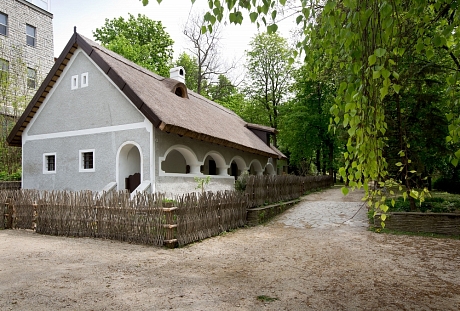Veszprém Bakonyi House, The Country House of the Year
Veszprém Bakonyi House, THE COUNTRY HOUSE MUSEUM OF THE YEAR
– the professional recognition was awarded by the Association of Hungarian Country House Museums in 2019 to the collection of the Veszprém Bakonyi House, Lackó Dezső Museum.
Celebrating the 85th anniversary of its establishment next year, the Veszprém Bakonyi House, being the first country house museum in Transdanubia (Dunántúl) and the second country house museum in the Hungarian-speaking area, is one of the early examples of the ‘Hungarian Skansen’ idea, which later developed into a museological discipline. Today, it has significance in science history, museum history and at the same time urban history.
In Erzsébet-liget, Veszprém, the farmhouse built in 1935 housing the Bakonyi House, Laczkó Dezső Museum, has had a permanent ethnographic exhibition from the very beginning. Its establishment was mainly due to the fact that there were few opportunities to present the rich ethnographic material in the museum's permanent exhibition. By 1935, the need for an ethnographic exhibition space and the presentation of the original purpose, functional environment and living space of the artefacts had evolved into an explicit goal.
The Bakonyi House is a three-division dwelling house with an arched porch, a typical, fairly characteristic folk architecture style around Veszprém, which characterised the villages inhabited by the gentry in particular. Its direct antecedent is the residence of István Simon in Öcs village. Full contemporary documentation of the construction and history of the house is available, and the entire history of the exhibition space can be reconstructed. In the 1930s and 1940s, the Bakonyi House was considered one of the exemplary authentic ethnographic houses for the scientific community, as opposed to other the demonstration sites built in a ‘folksy style’.
The Bakonyi House was built from public donations; in addition to the community of Veszprém County and the city of Veszprém, 11 industrial companies, organisations and countless private individuals contributed. The craftsmen and traders of Veszprém helped to build the house with their work. Today, we would say that the house embodies the work of active communities, as its creation was based on community participation. It was inaugurated in August 1935 as part of the Veszprém Festive Weeks, and since then it has also functioned as a folk art and cottage industry showroom. In the workshop at the back of the house, József Illikman, the last traditional folk wooden flask maker of Veszprém worked, and young people dressed in local costumes gave a presentation in the house during city events, so ahead of its time, as an interactive exhibition space, it was an important venue for the presentation of city and county identity.
The designer was architect György Linzmayer, the exhibition was made by the museum attendant László Nagy, and the interior consisted of a living room, a kitchen and a wooden flask making workshop. In 1951, the house was renewed based on the concept of Aurél Vajkai. The door to the first room from the porch was walled in and a door to the room was created from the kitchen. Painted furniture was replaced with hardwood carved furniture typical of gentry home culture. It also retained its special value with the establishment of open air ethnographic museums in 1970, and has since has been considered a true ‘farmhouse in the heart of the city’.
In 1983, another rearrangement took place carried out under the leadership and according to the plan of dr. Emőke Lackovits based on her research results. The house then became a showcase for the Reformed gentry housing culture, which image has been retained to this day.
We tend to see folk culture as timeless, ancient, or eternal. The exhibition entitled ‘Timeless Times !?’ opened in the backroom in 2016 based on the plans of dr. Veronika Schleicher, intended to nuance this picture by presenting some objects with the date of making indicated on them. The issues raised in the exhibition draw attention to the diversity of folk culture that can be grasped and determined in historical time.
Today, the area around the house is an ethnobotanical training garden, which provides a selection of wild and cultivated plants typical of the area. About two hundred plants were selected to present their role in local peasant culture and folklore in as many ways as possible.
In recent years, the Bakonyi Ház has become a popular city event venue, mainly due to a mobile oven, and baking bread and ‘langalló’ (flat bread) is very popular. The transfer of traditions and customs to the younger generations, kindergarten and school groups, and also museum educational sessions enhance the significant role of the institution in cultural life.
| |








